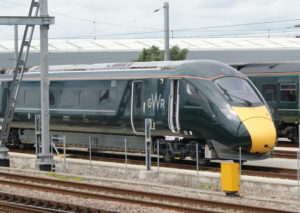The following entry is a record in the “Catalogue of Catastrophe” – a list of failed or troubled projects from around the world.
Organization: Network Rail – UK
Project type : Rail infrastructure upgrade
Project name : Great Western Mainline electrification project
Date : Jan 2020
Cost : £2B cost overrun, plus reduced scope
Synopsis :
The electrification of the world’s transportation infrastructure is a growing focus in many countries. Electrification allows the energy intensive industry to move to renewable sources of energy and helps contribute to climate action goals. It also means projects. In fact, as older legacy technology is migrated to the electrical grid, it means lots of projects

New Hitachi 800 bi-mode diesel-electric CC BY-SA 4.0
An example that illustrates the challenge in migrating old infrastructure to more modern standards is provided by the Great Western rail line in the UK. Connecting London to Wales, the famous track was built by the legendary Victorian engineer Isambard Kingdom Brunel in the 1830’s. Although an engineering marvel, it was of course designed for steam and lower speeds.
The passing of steam in the 1950’s saw the introduction of diesel trains and the modern push to electrification is seeing diesel displaced by electric. While the migration to diesel required little investment (other than the purchase of new engines), the move to electrical power requires a power distribution system to be built along the entire length of the track. Affecting bridges, tunnels and crossings, the work also required the construction of 4,200 overhead gantries, overhead cabling throughout and the addition of 49 power distribution facilities along the track.
At the time the project was approved in 2013, the construction of that infrastructure was priced at £874m. With the project is now reaching its conclusion, the actual costs have risen to £2.8bn. Compounding the increase in costs is the fact the originally planned link from Cardiff to Swansea was cut, thereby reducing the project’s scope by 20%.
In explaining the cost overruns to the Government’s Public Accounts Committee, the then CEO of Network Rail noted that the cost overruns were triggered by a “combination of inadequate planning, estimates that were based on outdated knowledge of the railways and a change in the flexibility of the regulatory regime”. Given that Network Rail owns the track and has full access to all necessary data, that seems to be a superficial veneer on top of a set of deeper underlying causes. Beneath the veneer are some fairly obvious questions such as: Why was the planning insufficient? Why was estimates based on “outdated knowledge”?
A document published by the UK’s National Audit Office casts some light on those questions. In reference to the fact that the original cost estimates were unrealistic, the audit noted that Network Rail was “too optimistic about the productivity of new technology. It underestimated how many bridges it would need to rebuild or modify and also the time and therefore costs needed to obtain planning permission and other consents for some works. Failings in Network Rail’s approach to planning and delivering the infrastructure programme further increased costs. It did not work out a ‘critical path’ – the minimum feasible schedule for the work, including dependencies between key stages – before starting to deliver electrification. It also did not conduct sufficiently detailed surveys of the locations for the structures, which meant that some design work had to be repeated”.
To me that explanation points back to a lack of Project Management controls and rigour, which in turn raises serious questions about the leadership and governance structures within the organization as a whole.
Contributing factors as reported in the press:
Underestimation of complexity. Inadequate planning. Lack of due diligence in estimating. Lack of appropriate Project Management controls, checks and balances.
Related stories:
- British Rail – Advanced Passenger Train – Efforts to design a titling train in the 1970’s to allow the old rail lines to achieve higher speed ends in failure and embarrassment.
Reference links:
- Audit summary – Modernizing the Great Western railway (note the audit covers not just the electrification of the track, but also other elements of the overall electrification program – e.g. buying new rolling stock and other system upgrades)
- MPs cast doubts over rail electrification timetable
- Cost of Great Western mainline electrification project triples to £2.8bn
- London to Cardiff rail electrification opens after years of delays and cost hikes